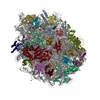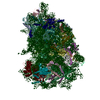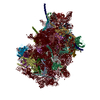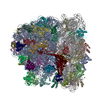+ データを開く
データを開く
- 基本情報
基本情報
| 登録情報 | データベース: PDB / ID: 7qws | |||||||||||||||
|---|---|---|---|---|---|---|---|---|---|---|---|---|---|---|---|---|
| タイトル | Structure of ribosome translating beta-tubulin in complex with TTC5 and NAC | |||||||||||||||
 要素 要素 |
| |||||||||||||||
 キーワード キーワード | RIBOSOME / SRP / NAC / nascent chain / co-translational / Endoplasmic reticulum / co-translational protein targeting / co-translational folding | |||||||||||||||
| 機能・相同性 |  機能・相同性情報 機能・相同性情報negative regulation of protein localization to endoplasmic reticulum / nascent polypeptide-associated complex / negative regulation of striated muscle cell apoptotic process / regulation of skeletal muscle fiber development / positive regulation of cell proliferation involved in heart morphogenesis / positive regulation of skeletal muscle tissue growth / Major pathway of rRNA processing in the nucleolus and cytosol / GTP hydrolysis and joining of the 60S ribosomal subunit / L13a-mediated translational silencing of Ceruloplasmin expression / SRP-dependent cotranslational protein targeting to membrane ...negative regulation of protein localization to endoplasmic reticulum / nascent polypeptide-associated complex / negative regulation of striated muscle cell apoptotic process / regulation of skeletal muscle fiber development / positive regulation of cell proliferation involved in heart morphogenesis / positive regulation of skeletal muscle tissue growth / Major pathway of rRNA processing in the nucleolus and cytosol / GTP hydrolysis and joining of the 60S ribosomal subunit / L13a-mediated translational silencing of Ceruloplasmin expression / SRP-dependent cotranslational protein targeting to membrane / Formation of a pool of free 40S subunits / Nonsense Mediated Decay (NMD) independent of the Exon Junction Complex (EJC) / Nonsense Mediated Decay (NMD) enhanced by the Exon Junction Complex (EJC) / cardiac ventricle development / positive regulation of mRNA catabolic process / heart trabecula morphogenesis / skeletal muscle tissue regeneration / ribosomal subunit / ubiquitin ligase inhibitor activity / positive regulation of signal transduction by p53 class mediator / rough endoplasmic reticulum / MDM2/MDM4 family protein binding / cytosolic ribosome / maturation of LSU-rRNA from tricistronic rRNA transcript (SSU-rRNA, 5.8S rRNA, LSU-rRNA) / cellular response to starvation / ribosomal large subunit biogenesis / Regulation of TP53 Activity through Methylation / wound healing / antimicrobial humoral immune response mediated by antimicrobial peptide / protein transport / large ribosomal subunit / regulation of translation / ribosome binding / 5S rRNA binding / ribosomal large subunit assembly / cytoplasmic vesicle / large ribosomal subunit rRNA binding / defense response to Gram-negative bacterium / cytosolic large ribosomal subunit / killing of cells of another organism / in utero embryonic development / cytoplasmic translation / transcription coactivator activity / tRNA binding / postsynaptic density / rRNA binding / structural constituent of ribosome / ribosome / translation / mitochondrial matrix / ribonucleoprotein complex / DNA repair / mRNA binding / synapse / DNA damage response / chromatin binding / nucleolus / endoplasmic reticulum / negative regulation of transcription by RNA polymerase II / positive regulation of transcription by RNA polymerase II / mitochondrion / DNA binding / RNA binding / extracellular exosome / zinc ion binding / nucleoplasm / nucleus / cytosol / cytoplasm 類似検索 - 分子機能 | |||||||||||||||
| 生物種 |  Homo sapiens (ヒト) Homo sapiens (ヒト) | |||||||||||||||
| 手法 | 電子顕微鏡法 / 単粒子再構成法 / クライオ電子顕微鏡法 / 解像度: 3.4 Å | |||||||||||||||
 データ登録者 データ登録者 | Jomaa, A. / Gamerdinger, M. / Hsieh, H. / Wallisch, A. / Chandrasekaran, V. / Ulusoy, Z. / Scaiola, A. / Hegde, R. / Shan, S. / Ban, N. / Deuerling, E. | |||||||||||||||
| 資金援助 |  米国, 4件 米国, 4件
| |||||||||||||||
 引用 引用 |  ジャーナル: Science / 年: 2022 ジャーナル: Science / 年: 2022タイトル: Mechanism of signal sequence handover from NAC to SRP on ribosomes during ER-protein targeting. 著者: Ahmad Jomaa / Martin Gamerdinger / Hao-Hsuan Hsieh / Annalena Wallisch / Viswanathan Chandrasekaran / Zeynel Ulusoy / Alain Scaiola / Ramanujan S Hegde / Shu-Ou Shan / Nenad Ban / Elke Deuerling /     要旨: The nascent polypeptide-associated complex (NAC) interacts with newly synthesized proteins at the ribosomal tunnel exit and competes with the signal recognition particle (SRP) to prevent mistargeting ...The nascent polypeptide-associated complex (NAC) interacts with newly synthesized proteins at the ribosomal tunnel exit and competes with the signal recognition particle (SRP) to prevent mistargeting of cytosolic and mitochondrial polypeptides to the endoplasmic reticulum (ER). How NAC antagonizes SRP and how this is overcome by ER targeting signals are unknown. Here, we found that NAC uses two domains with opposing effects to control SRP access. The core globular domain prevented SRP from binding to signal-less ribosomes, whereas a flexibly attached domain transiently captured SRP to permit scanning of nascent chains. The emergence of an ER-targeting signal destabilized NAC's globular domain and facilitated SRP access to the nascent chain. These findings elucidate how NAC hands over the signal sequence to SRP and imparts specificity of protein localization. | |||||||||||||||
| 履歴 |
|
- 構造の表示
構造の表示
| ムービー |
 ムービービューア ムービービューア |
|---|---|
| 構造ビューア | 分子:  Molmil Molmil Jmol/JSmol Jmol/JSmol |
- ダウンロードとリンク
ダウンロードとリンク
- ダウンロード
ダウンロード
| PDBx/mmCIF形式 |  7qws.cif.gz 7qws.cif.gz | 3.1 MB | 表示 |  PDBx/mmCIF形式 PDBx/mmCIF形式 |
|---|---|---|---|---|
| PDB形式 |  pdb7qws.ent.gz pdb7qws.ent.gz | 表示 |  PDB形式 PDB形式 | |
| PDBx/mmJSON形式 |  7qws.json.gz 7qws.json.gz | ツリー表示 |  PDBx/mmJSON形式 PDBx/mmJSON形式 | |
| その他 |  その他のダウンロード その他のダウンロード |
-検証レポート
| 文書・要旨 |  7qws_validation.pdf.gz 7qws_validation.pdf.gz | 1.7 MB | 表示 |  wwPDB検証レポート wwPDB検証レポート |
|---|---|---|---|---|
| 文書・詳細版 |  7qws_full_validation.pdf.gz 7qws_full_validation.pdf.gz | 1.7 MB | 表示 | |
| XML形式データ |  7qws_validation.xml.gz 7qws_validation.xml.gz | 212.4 KB | 表示 | |
| CIF形式データ |  7qws_validation.cif.gz 7qws_validation.cif.gz | 363.7 KB | 表示 | |
| アーカイブディレクトリ |  https://data.pdbj.org/pub/pdb/validation_reports/qw/7qws https://data.pdbj.org/pub/pdb/validation_reports/qw/7qws ftp://data.pdbj.org/pub/pdb/validation_reports/qw/7qws ftp://data.pdbj.org/pub/pdb/validation_reports/qw/7qws | HTTPS FTP |
-関連構造データ
- リンク
リンク
- 集合体
集合体
| 登録構造単位 | 
|
|---|---|
| 1 |
|
- 要素
要素
-タンパク質・ペプチド , 1種, 1分子 s
| #1: タンパク質・ペプチド | 分子量: 2060.531 Da / 分子数: 1 / 由来タイプ: 組換発現 / 由来: (組換発現)  Homo sapiens (ヒト) / 発現宿主: Homo sapiens (ヒト) / 発現宿主:  |
|---|
-タンパク質 , 8種, 8分子 tuDFopXK
| #2: タンパク質 | 分子量: 23406.824 Da / 分子数: 1 / 由来タイプ: 天然 / 由来: (天然)  |
|---|---|
| #3: タンパク質 | 分子量: 17724.037 Da / 分子数: 1 / 由来タイプ: 天然 / 由来: (天然)  |
| #10: タンパク質 | 分子量: 34481.828 Da / 分子数: 1 / 由来タイプ: 天然 / 由来: (天然)  |
| #14: タンパク質 | 分子量: 26662.787 Da / 分子数: 1 / 由来タイプ: 天然 / 由来: (天然)  |
| #31: タンパク質 | 分子量: 16130.169 Da / 分子数: 1 / 由来タイプ: 天然 / 由来: (天然)  |
| #33: タンパク質 | 分子量: 10299.350 Da / 分子数: 1 / 由来タイプ: 天然 / 由来: (天然)  |
| #43: タンパク質 | 分子量: 17768.246 Da / 分子数: 1 / 由来タイプ: 天然 / 由来: (天然)  |
| #47: タンパク質 | 分子量: 48988.418 Da / 分子数: 1 / 由来タイプ: 組換発現 / 由来: (組換発現)  Homo sapiens (ヒト) / 遺伝子: TTC5 / 発現宿主: Homo sapiens (ヒト) / 遺伝子: TTC5 / 発現宿主:  |
-60S ribosomal protein ... , 20種, 20分子 AbcCEfgGhHiIMnPrRTZa
| #4: タンパク質 | 分子量: 26701.301 Da / 分子数: 1 / 由来タイプ: 天然 / 由来: (天然)  |
|---|---|
| #5: タンパク質 | 分子量: 24608.236 Da / 分子数: 1 / 由来タイプ: 天然 / 由来: (天然)  |
| #7: タンパク質 | 分子量: 12821.092 Da / 分子数: 1 / 由来タイプ: 天然 / 由来: (天然)  |
| #8: タンパク質 | 分子量: 46388.855 Da / 分子数: 1 / 由来タイプ: 天然 / 由来: (天然)  |
| #12: タンパク質 | 分子量: 33055.297 Da / 分子数: 1 / 由来タイプ: 天然 / 由来: (天然)  |
| #13: タンパク質 | 分子量: 12580.809 Da / 分子数: 1 / 由来タイプ: 天然 / 由来: (天然)  |
| #15: タンパク質 | 分子量: 14557.543 Da / 分子数: 1 / 由来タイプ: 天然 / 由来: (天然)  |
| #16: タンパク質 | 分子量: 36267.605 Da / 分子数: 1 / 由来タイプ: 天然 / 由来: (天然)  |
| #17: タンパク質 | 分子量: 14566.599 Da / 分子数: 1 / 由来タイプ: 天然 / 由来: (天然)  |
| #18: タンパク質 | 分子量: 21871.418 Da / 分子数: 1 / 由来タイプ: 天然 / 由来: (天然)  |
| #19: タンパク質 | 分子量: 11888.371 Da / 分子数: 1 / 由来タイプ: 天然 / 由来: (天然)  |
| #20: タンパク質 | 分子量: 24643.057 Da / 分子数: 1 / 由来タイプ: 天然 / 由来: (天然)  |
| #26: タンパク質 | 分子量: 23810.432 Da / 分子数: 1 / 由来タイプ: 天然 / 由来: (天然)  |
| #29: タンパク質・ペプチド | 分子量: 3473.451 Da / 分子数: 1 / 由来タイプ: 天然 / 由来: (天然)  |
| #32: タンパク質 | 分子量: 17758.678 Da / 分子数: 1 / 由来タイプ: 天然 / 由来: (天然)  |
| #35: タンパク質 | 分子量: 15783.614 Da / 分子数: 1 / 由来タイプ: 天然 / 由来: (天然)  |
| #36: タンパク質 | 分子量: 23535.281 Da / 分子数: 1 / 由来タイプ: 天然 / 由来: (天然)  |
| #38: タンパク質 | 分子量: 18609.988 Da / 分子数: 1 / 由来タイプ: 天然 / 由来: (天然)  |
| #48: タンパク質 | 分子量: 15835.831 Da / 分子数: 1 / 由来タイプ: 天然 / 由来: (天然)  |
| #49: タンパク質 | 分子量: 16620.561 Da / 分子数: 1 / 由来タイプ: 天然 / 由来: (天然)  |
-Ribosomal protein ... , 17種, 17分子 BdejJkLlmNOQSUVWY
| #6: タンパク質 | 分子量: 46107.977 Da / 分子数: 1 / 由来タイプ: 天然 / 由来: (天然)  |
|---|---|
| #9: タンパク質 | 分子量: 14494.938 Da / 分子数: 1 / 由来タイプ: 天然 / 由来: (天然)  |
| #11: タンパク質 | 分子量: 18350.049 Da / 分子数: 1 / 由来タイプ: 天然 / 由来: (天然)  |
| #21: タンパク質 | 分子量: 11111.032 Da / 分子数: 1 / 由来タイプ: 天然 / 由来: (天然)  |
| #22: タンパク質 | 分子量: 20288.465 Da / 分子数: 1 / 由来タイプ: 天然 / 由来: (天然)  |
| #23: タンパク質 | 分子量: 8107.752 Da / 分子数: 1 / 由来タイプ: 天然 / 由来: (天然)  |
| #24: タンパク質 | 分子量: 24216.525 Da / 分子数: 1 / 由来タイプ: 天然 / 由来: (天然)  |
| #25: タンパク質 | 分子量: 6426.759 Da / 分子数: 1 / 由来タイプ: 天然 / 由来: (天然)  |
| #27: タンパク質 | 分子量: 14758.394 Da / 分子数: 1 / 由来タイプ: 天然 / 由来: (天然)  |
| #28: タンパク質 | 分子量: 24207.285 Da / 分子数: 1 / 由来タイプ: 天然 / 由来: (天然)  |
| #30: タンパク質 | 分子量: 56501.578 Da / 分子数: 1 / 由来タイプ: 天然 / 由来: (天然)  |
| #34: タンパク質 | 分子量: 21457.391 Da / 分子数: 1 / 由来タイプ: 天然 / 由来: (天然)  |
| #37: タンパク質 | 分子量: 20696.363 Da / 分子数: 1 / 由来タイプ: 天然 / 由来: (天然)  |
| #39: タンパク質 | 分子量: 12208.967 Da / 分子数: 1 / 由来タイプ: 天然 / 由来: (天然)  |
| #40: タンパク質 | 分子量: 14892.505 Da / 分子数: 1 / 由来タイプ: 天然 / 由来: (天然)  |
| #41: タンパク質 | 分子量: 17825.111 Da / 分子数: 1 / 由来タイプ: 天然 / 由来: (天然)  |
| #45: タンパク質 | 分子量: 17303.363 Da / 分子数: 1 / 由来タイプ: 天然 / 由来: (天然)  |
-RNA鎖 , 3種, 3分子 578
| #42: RNA鎖 | 分子量: 1539032.000 Da / 分子数: 1 / 由来タイプ: 天然 / 由来: (天然)  |
|---|---|
| #44: RNA鎖 | 分子量: 38691.914 Da / 分子数: 1 / 由来タイプ: 天然 / 由来: (天然)  |
| #46: RNA鎖 | 分子量: 50143.648 Da / 分子数: 1 / 由来タイプ: 天然 / 由来: (天然)  |
-非ポリマー , 2種, 102分子 


| #50: 化合物 | ChemComp-ZN / #51: 化合物 | ChemComp-MG / |
|---|
-詳細
| 研究の焦点であるリガンドがあるか | N |
|---|
-実験情報
-実験
| 実験 | 手法: 電子顕微鏡法 |
|---|---|
| EM実験 | 試料の集合状態: PARTICLE / 3次元再構成法: 単粒子再構成法 |
- 試料調製
試料調製
| 構成要素 |
| ||||||||||||||||||||||||||||||
|---|---|---|---|---|---|---|---|---|---|---|---|---|---|---|---|---|---|---|---|---|---|---|---|---|---|---|---|---|---|---|---|
| 由来(天然) |
| ||||||||||||||||||||||||||||||
| 由来(組換発現) |
| ||||||||||||||||||||||||||||||
| 緩衝液 | pH: 7.5 | ||||||||||||||||||||||||||||||
| 試料 | 包埋: NO / シャドウイング: NO / 染色: NO / 凍結: YES | ||||||||||||||||||||||||||||||
| 試料支持 | グリッドのタイプ: Quantifoil R2/2 | ||||||||||||||||||||||||||||||
| 急速凍結 | 装置: FEI VITROBOT MARK IV / 凍結剤: ETHANE-PROPANE / 湿度: 95 % |
- 電子顕微鏡撮影
電子顕微鏡撮影
| 実験機器 |  モデル: Titan Krios / 画像提供: FEI Company |
|---|---|
| 顕微鏡 | モデル: FEI TITAN KRIOS |
| 電子銃 | 電子線源:  FIELD EMISSION GUN / 加速電圧: 300 kV / 照射モード: FLOOD BEAM FIELD EMISSION GUN / 加速電圧: 300 kV / 照射モード: FLOOD BEAM |
| 電子レンズ | モード: BRIGHT FIELD / 最大 デフォーカス(公称値): 3000 nm / 最小 デフォーカス(公称値): 1000 nm |
| 試料ホルダ | 凍結剤: NITROGEN 試料ホルダーモデル: FEI TITAN KRIOS AUTOGRID HOLDER |
| 撮影 | 電子線照射量: 50 e/Å2 フィルム・検出器のモデル: FEI FALCON III (4k x 4k) |
- 解析
解析
| CTF補正 | タイプ: PHASE FLIPPING AND AMPLITUDE CORRECTION |
|---|---|
| 3次元再構成 | 解像度: 3.4 Å / 解像度の算出法: FSC 0.143 CUT-OFF / 粒子像の数: 83053 / 対称性のタイプ: POINT |
| 原子モデル構築 | プロトコル: RIGID BODY FIT / 空間: REAL |
| 原子モデル構築 | PDB-ID: 7OBR Accession code: 7OBR / Source name: PDB / タイプ: experimental model |
 ムービー
ムービー コントローラー
コントローラー


















 PDBj
PDBj


































